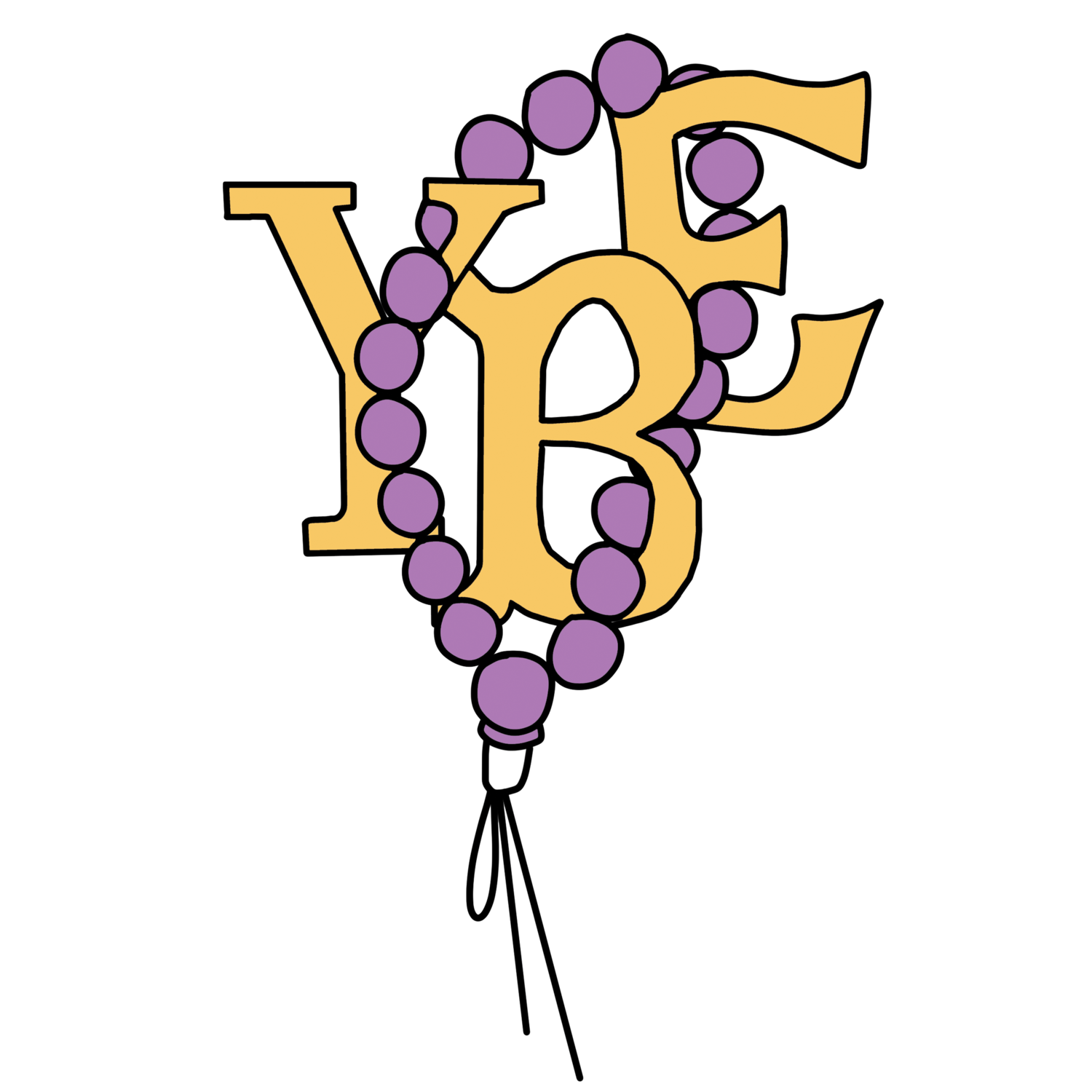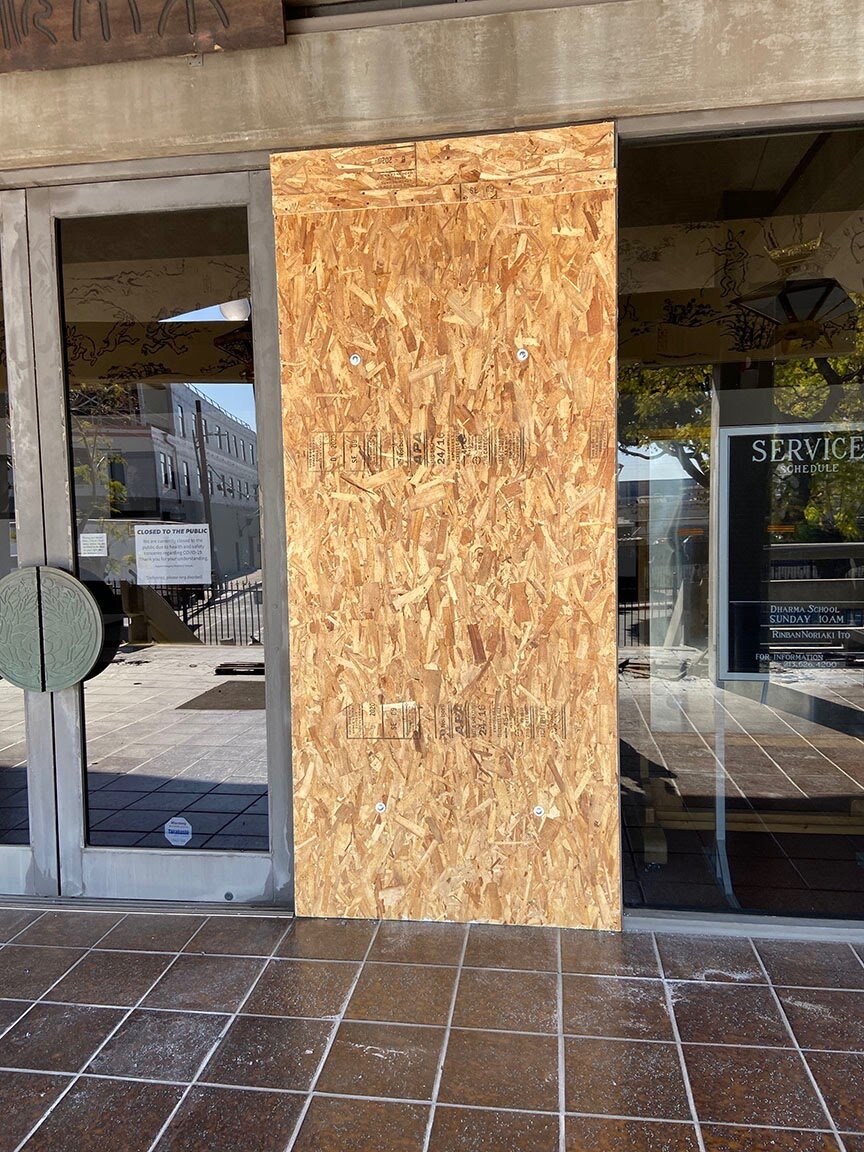A History We Know Too Well
By Devon Matsumoto | He/Him/His | President of YBE | Mountain View Buddhist Temple
On February 25th, 2021 the Higashi Honganji Buddhist Temple in Little Tokyo, Los Angeles was vandalized by a man who knocked down two metal lanterns, set fire to two wooden lantern holders that welcomed people to the temple, and as he left smashed a large glass window by throwing a rock into it. At the time that this article is being written, this vandalism is not being deemed a racially motivated crime. However, this act of violence against a Japanese American temple comes at a time when hate crimes against Asian Americans is on the rise in the United States and thus, whether a hate crime or not, should be viewed within the larger context of the Asian American struggle and movements for Black, Indigenous and POC solidarity.
Acts of vandalism and violence against our Japanese American Buddhist temples are nothing new. By virtue of being non-white and non-Chrisitan, we are inherently deviant from American norms of both race and religion, and are thus often targets for violence that is at once religious and racial. In his book American Sutra, Dr. Rev. Duncan Ryuken Williams details these pains and struggles, which the Japanese American Buddhist community has endured since the first Isseis arrived in the late 1800s. Even without Dr. Rev. William’s seventeen years of extensive research into our community, many of our families can recall this violence, whether from firsthand experience or in stories passed down from grandparent to grandchild.
Anti-Asian and and anti-Buddhist sentiment are not unique to only our community. In 2019, a Thai Buddhist temple was set on fire and shot up in Las Vegas; in April 2020 a Thai Buddhist temple was vandalized in Fort Smith; and in the Fall of 2020 multiple Vietnamese Buddhist temples in Little Saigon Los Angeles were heavily vandalized.
These incidents have shown that whether we choose to accept it or not, being a Japanese American Buddhist is a political identity that cannot be erased no matter how much we aspire to a false sense of whiteness. Because of this history of persecution and violence, the pain in our community still exists whether or not the Higashi vandalism is officially deemed a hate crime. We must also recognize that these individual hate crimes are situated within larger state structured systems of violence which contributes to the suffering we experience. What we do with that pain can either drive us towards shared liberation, or implicate us in a cycle of white supremacy that makes us both the victim and perpetrator.
From my experience, the latter takes two forms; interpersonal conflict and systemic violence. Interpersonal conflict can look like theft, robbery, assault, murder, arson, etc. and it doesn’t take much to know that these actions cause harm. However, these acts are oftentimes a result of systemic violence. Systemic violence is a much more complex issue with a multitude of moving parts, many of which are difficult to identify unless specifically looking for it. More easily identifiable acts of systemic violence can look like anti-Asian propaganda being spread by government officials, the state sanctioned murders of Black folks and other people of color by police, and the incarceration of Japanese Americans during World War II. Other forms of systemic violence that are often overlooked are the hypersurveillance of Black, Muslim, and Latinx communities that leads to these murders, the lack of affordable housing, lack of affordable healthcare, the criminalization of poverty and mental illness, unlivable wages, perpetuating of the model minority myth, redlining, gentrificiation and the breaking up of communities of color, and much much more.
When a Sakura Tree has its branches ripped off in San Francisco Japantown, when San Jose Japantown struggles with constant break ins, and when Higashi Honganji Buddhist temple is vandalized in Little Tokyo, our community’s initial response is to treat these as isolated incidents of interpersonal conflict. The interpersonal violence we see, like the Honganji vandalism or physical assault on Asians, hides forms of systemic violence. Samoan organizer Terisa Saigatonu explains that these larger structures of harm, such as “poverty, houselessness, unemployment, the hoarding of resources on a city/state/federal level, have led to an increase of crime and intra-community turmoil rooted in white supremacy.” Our solutions to these problems usually involve us calling for more security and policing in our community, and tend to only address these issues in the short term while ignoring the systemic violence which is the root of many of these problems. Because of redlining, our Japantowns and Buddhist temples are located in historically low-resourced Asian, Black, and Latinx communities, and we replicate and perpetuate systems of oppression that not only harm Black and Brown communities but also harm our Japanese/Asian communities when we rely on the police to solve our problems or expand our surveillance equipment.
The safest communities are not those with the most police or the best surveillance equipment, but those with the most resources. While not perfect, our temples offer a glimpse into a future where we do not have to rely on police and the most vulnerable in our community get the resources they need. Over the years, we have chosen to invest in ABAs, BWAs, YBAs, YABAs, Scouts, taiko, sports, Dharma school, cultural classes and many other activities that have brought our community together and tended to our psychological, social, and spiritual needs. The temples have also acted as mutual-aid and social welfare organizations for our community as we have organized blood drives for community members, allowed families to stay in our houses when they lost their homes, and have pooled together money to help offset the costs of funerals or medical bills. These are just small examples of how our temples can reimagine safety while addressing harm in the community.
What does this look like outside of our Japanese American Buddhist community? Addressing systemic violence that leads to interpersonal conflict can be a long term solution that alleviates a lot of the harm between multi-ethnic communities. Supporting “housing first” initiatives that guarantee unconditional housing for the unhoused, advocating for universal healthcare, combating systemic racism and anti-Blackness, investing in mutual-aid organizations, divesting in police and investing in community, decriminalizing mental illness and poverty, the list goes on. Rather than rely on a system that terrorizes BIPOC and low-income communities we must seek out sustainable and equitable changes for the most marginalized and vulnerable in order to build and move towards collective liberation and solidarity.
Rev. Bob recently told me of a conversation he had with an Issei Baachan, Mrs. Kiyo Hirano, regarding the incarceration experience. She told him,
“Sono Camp no hanashii mo yamenasai…
Mochiron Camp wa tsurakatta…
Demo…sore wa watashi-tashi no kuro desu. Anata no Kuro de nai…
Mo ii yo…Yamenasai”.
“Stop talking about camp…
Of course it was painful…
But that is our pain to carry. It is not your pain…
It’s okay…please stop”.
This Baachan told Rev. Bob not to pick up her pain because it will poison him. Rev. Bob said those of us who followed have been given a wonderful gift from those who endured the humiliation of “camp”. That gift is to live without anger and hate for things that were done to people we love. What I take from this lesson is that our actions should not be guided by hate and instead with wisdom and compassion. When our temples and communities get vandalized or threatened, calling for more police, hiring more security, and increasing surveillance of the temple will only offer short term solutions that replicate systems of harm that disproportionately affect Black, Indigenous and other communities of color. To act with wisdom and compassion is to seek out community based and community led alternatives that address harm without having to endanger the lives of our most vulnerable community members. The good news is that there are many Japanese American groups across the country already working towards making our communities safe, healthy, sustainable, and equitable by reimagining public safety and addressing systemic issues that lead to violence in and against our communities. These groups are working in solidarity with Black led and other multi-ethnic community groups to ensure that our liberation is intersectional, equitable, and truly addresses the violence we tend to ignore. The future is now and cannot wait for another generation.
All photos courtesy of Rev. Bob Oshita and Rev. Nori Ito.
A special thank you to Rev. Bob Oshita and Mariko Fujimoto Rooks for reviewing and editing the article.
Japanese American Organizations to look into:
Southern California:
Jtown Action and Solidarity
Nikkei Progressives
Sustainable Little Tokyo
Vigilant Love
Bay Area CA
SF Bay Area Nikkei Resisters
Jasforjustice
New York
New York Day of Remembrance
Chicago
Nikkei Uprising
National
Tsuru for Solidarity





